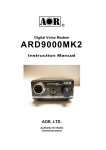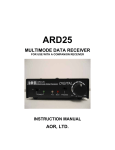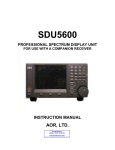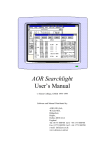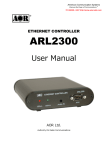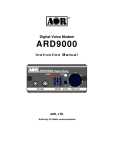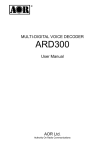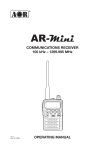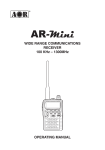Download AOR AR-STV Specifications
Transcript
® AR-STV WIRELESS CAMERA DETECTOR Operating manual AOR, LTD. TABLE OF CONTENTS 1 Introduction -------------------------------------------------------------------------------------1-1 Maintaining the unit --------------------------------------------------------------------------1-2 Power requirements -------------------------------------------------------------------------1-3 Supplied accessories -----------------------------------------------------------------------1-4 Features ----------------------------------------------------------------------------------------- 2 2 2 3 3 2 Control and functions------------------------------------------------------------------------- 3 2-1 Front panel controls--------------------------------------------------------------------------- 3 2-2 Rear Panel -------------------------------------------------------------------------------------- 6 3 Connections--------------------------------------------------------------------------------------- 7 4 Power Switch------------------------------------------------------------------------------------- 7 5 Operations of the AR-STV ------------------------------------------------------------------5-1 Display ------------------------------------------------------------------------------------------5-2 Operation mode ------------------------------------------------------------------------------5-2-1 Search mode -------------------------------------------------------------------------------5-2-2 Memory mode ------------------------------------------------------------------------------5-2-3 Setting mode -------------------------------------------------------------------------------5-3 PC interface ------------------------------------------------------------------------------------ 7 7 8 8 11 13 15 6 Specifications------------------------------------------------------------------------------------ 16 7 Limited warranty (USA only)---------------------------------------------------------------- 17 FCC statement This device complies with Part 15 of the FCC rules. Operation is subject to the following two conditions: (1) This device may not cause harmful interference, and (2) This device must accept any interference received, including interference that may cause undesired operation. 1 1 Introduction Thank you for purchasing the AR-STV Wireless Camera Detector. The AR-STV is a wireless camera receiver with a 2.5 inch color LCD display, still picture recorder and sensor that captures analog video signals in real-time. It is mainly designed for use in surveillance applications. Its built-in clock allows images to be time-stamped and a (non-supplied) SD memory card can be used to store images. © This manual is protected by copyright AOR, LTD. 2013. No information contained in this manual may be copied or transferred by any means without the prior written consent of AOR, LTD. AOR and the AOR logo are trademarks of AOR, LTD. All other trademarks and names are acknowledged. 1-1 Maintaining the unit There are no internal operator adjustments. In the unlikely event of service being required, please contact your dealer for technical assistance. Level of risk: As the AR-STV operates with a 6 V DC power source, there is little chance of serious injury as long as common sense is applied. Observe the polarity of connections if using an external battery charger. DC input is a nominal 6V DC, with the connector wired center conductor positive. Reverse polarity connection will damage the AR-STV and could lead to the risk of fire or explosion under severe circumstances. NEVER connect the AR-STV directly to the AC outlet. Handling the AR-STV: Use a soft, dry cloth to gently wipe the AR-STV clean. Never use abrasive cleaners or organic solvents which may damage certain parts. Treat the unit with care, avoid spillage or leakage of liquids into the cabinet and power supply. Special care should be taken to avoid liquid entering around the keys, main dial or via the connectors. [Note: Never push or knock the LCD screen – it is very fragile and sensitive to shock.] Special remarks: Do not use or leave the AR-STV in direct sunlight (especially the TFT display). It is best to avoid locations where excessive heat, humidity, dust and vibration are expected. Always keep the AR-STV free from dust and moisture. 1-2 Power requirements The AR-STV is designed for operation from a nominal 6 V DC (4 AA size alkaline battery or Ni-MH cells). The external 6V DC power supply may be used to charge the internal Ni-MH cells. Do not use an external power supply when alkaline battery cells are in the unit. [ Notice: Always disconnect the external power supply when in use.] 2 1-3 Supplied accessories The following accessories are provided in the shipping box. Instruction manual (this booklet) Flexible rubber antenna Belt clip Soft case Four AA size Ni-MH battery cells DC power supply / battery charger 1-4 Features Built-in 2.5 inch color LCD display Built-in clock for time stamp Store images on a (non-supplied) SD (or SDHC) memory card Detect NTSC, PAL, CCIR, EIA or scrambled reverse polarity video signals Receives and displays video signals on L-band (1.2 GHz) or S-band (2.4 GHz) The USB connector makes it easy to download stored images into a computer Easy to operate with four AA size batteries Continuous search between 900 ~ 2800 MHz 10 search banks Easy menu-driven operation 2 Controls and functions 2-1 Front panel The front panel of the AR-STV is dominated by the large color LCD. On the top right corner of the AR-STV, there is a red LED marked as “STA” (Status). The LED blinks while in the search mode. Front View 3 Left View Right View Right Side of the AR-STV 1 Power ON/OFF switch Slide the power switch upward to switch on the AR-STV. To switch off the AR-STV, slide the switch downward. 2 CONT (USB connector) Using a USB A ←→ USB Mini (B) cable (not supplied), connect between the CONT (Control) connector and a PC to download images which have been previously 3 VIDEO (Video Output connector) This 3.5 mm mono connector provides the composite video output. An external video monitor may be connected. 4 4 DC 6V (External power input connector) To charge the internal Ni-MH cells, connect the supplied DC power supply into this connector. Note that the center pin of the jack is positive. 5 SD (SD, SDHC memory card slot) Insert a (non-supplied) SD memory card (up to 32 GB) into this slot to save images. Approx. 20,000 images may be saved on a 1GB SD card. 6 ALM OUT (Alarm output connector) Connect an external alarm device into this connector. (Format: 3.5 mm stereo) Pin assignment of the connector: Tip --- Beep output and alarm output Ring --Relay output (this pin will make a short circuit to the ground for 2 seconds after a video signal is detected) (Relay specifications: 50 V DC, 150 mA max.) Sleeve--- Ground 5 Left Side of the AR-STV 7 MODE (Mode selector) switch Press this switch to select the operation mode. 8 REC (Record) switch Press this switch to store image onto memory. 9 FREQ UP DOWN (Frequency selector switch) Press this switch upward/downward to change the receive frequency or change search direction. 2-2 Rear panel Battery compartment With the supplied belt clip attached. 6 3 Connections Connect the supplied flexible rubber antenna to the SMA antenna connector on the top of the ARSTV. If required, an external antenna may be connected with a SMA connector for the coaxial cable. Insert the supplied 4 AA size Ni-MH cells into the battery compartment in the AR-STV. If the batteries are not yet charged, connect the DC power supply into the power input connector on the right side. 4 Power switch To switch on the AR-STV, slide the power switch on the right side of the AR-STV upward. 4-1 Start-up After inserting the batteries, switch on the power switch. The LCD displays search screen and a STA (Status) LED will blink indicating the AR-STV is in the search mode. 4-2 Powering down To switch off the AR-STV, slide down the power switch. 4-3 Low Battery When internal battery voltage becomes low, the Low Battery indicator will appear on the LCD screen. In the meantime, a beep will sound. When this message appears on the screen, all operations of the ARSTV will quit automatically. Immediately switch off the AR-STV, and replace all internal battery cells with new ones or charge the supplied batteries by connecting the DC powers supply. (Charging time approx. 10h) 5 Operations of the AR-STV To set or remove the key lock, press the blue button and FREQ.DOWN switch simultaneously. 5-1 Display This section explains what you can expect to see on the AR-STV LCD monitor screen. Once the AR-STV is properly powered up, this display will appear on the screen: 7 (1) 1G 2G 3G (Hz) The horizontal axis displays the receive frequency. The AR-STV can receive between 900 MHz and 2800 MHz. (1G indicates 1 GHz in frequency, 2 G for 2 GHz, and 3 G for 3 GHz accordingly.) (2) V (Video level) N (Noise level) Video Level The V (Video) line on the vertical axis displays the video quality threshold level. Note that video level is NOT related to the signal strength. Setting the video threshold level higher will display the video signal only with the better quality. Setting the video threshold level lower will display the video signal even if it is of poor quality. Noise Level The N (Noise) line on the vertical axis displays the signal strength. Setting the Noise threshold level higher can detect only strong signals. Setting the Noise threshold level lower can detect any weak signals even of poor quality. Video Level and Noise level can be adjusted on the Search Bank Setting Menu. 5-2 Operation Mode There are three (3) operation modes with the AR-STV. • • • Search Mode Memory Mode Setting Mode 5-2-1 Search Mode This is a default operation mode of the AR-STV. On this mode, the AR-STV will search frequencies between 900 MHz ~ 2.8 GHz (2800 MHz) continuously until signal is detected. Once the AR-STV detects the signal, it will automatically switch the screen to display the received video signal. To stop searching, press the FREQ switch inward. Then the screen on the right will appear. 8 Icon legend: Signal level Battery level Search bank Receive freq. SD card inside Search mode 5-2-1-1 Frequency adjustment To change the receive frequency, press the FREQ. switch upward or downward. 5-2-1-2 Recording image To record the received image, press and hold the REC switch for 3 seconds. (Note: To record an image, a non-supplied SD memory card must be installed in the AR-STV. Otherwise, a beep will sound, and the SD Error message will appear on the LCD screen.) 5-2-1-3 Search Bank setting To register a search bank, perform the following steps: 9 1. On the Search Mode screen, press and hold the MODE switch for 3 seconds 2. The following search bank setting screen will appear. Search: Search bank number 0 ~ 9. To change the search bank, press the MODE key. Start: Select the start frequency. (Frequency range: 900 ~ 2800MHz). On above example, 09 is highlighted in reverse color and 900 MHz has been set as the start frequency. To change the first 2 digits, press the FREQ. Switch inward. The highlighted area will change into green, indicating it is ready to change the parameter. Press the FREQ. switch upward or downward to select the desired frequency. To confirm entry, press the FREQ. switch inward again. The highlighted area will change into white. To change the last 2 digits of frequency, press the FREQ. switch downward. Repeat above steps to change the last 2 digits of frequency. End: Select the end frequency. (Frequency range: 900 ~ 2800MHz). On the above example, 2800 will be highlighted in reverse color as 2800 MHz has been set as the end frequency. To change the end frequency, perform the same procedures as the start frequency entry. 10 Step: Select the search frequency step. (Entry range: 2 ~ 10 MHz) To change the parameter, perform the same procedures as the start frequency entry. Noise Level: Select the noise threshold level. (Entry range: -30 ~ -80 db min 5 dB increments) Suggested level: 75 (for normal search) 0 (for weak signal) Run: Select the search bank enable or disable. To change the parameter, perform the same procedures as the start frequency entry Video Level: Select the video threshold level. (Entry range: 0 ~ 95 %) Suggested level: 60 (for normal search) 20 (for weak signal) If the parameter is set to 0, then the AR-STV searches with the noise level setting. 3. To exit from this setting screen, press and hold the MODE key for 3 seconds. 5-2-2 Memory mode In the Memory mode, you can change the memory channel setting, record images into memory. To use this function, a formatted SD memory card (not included) must be inserted in the SD slot. To go into the Memory mode, press the MODE key and REC key simultaneously. (If no SD memory card is in the slot, a beep will sound and a “SD Card No File” error message appears.) Memory mode screen: 11 Icon legend: Signal level Battery level Search bank Receive freq. SD card inside Search mode 5-2-2-1 Scroll memory channel To scroll the memory channel, press the FREQ. switch upward or downward. 5-2-2-2 Slide show To start a slide show of the recorded frequencies, press and hold the FREQ. switch for 3 seconds. 5-2-2-3 Change memory contents To change the recorded frequency of the memory channel, perform the following steps: 1. Press and hold the MODE switch for 3 seconds. 2. The frequency on the top right of the LCD will display in reverse color. 3. Press the FREQ. switch upward or downward to change the frequency. 4. To confirm entry, press and hold the FREQ. switch again for 3 seconds. 5-2-2-4 Recording image Press and hold the REC switch for 3 seconds. 12 To return to the search mode, press the MODE switch and REC switch simultaneously three times. (The operation mode will toggle between the Search mode, Memory mode, SD card mode, and setting mode.) 5-2-3 Setting mode There are two (2) setting pages: Setting 1 and Setting 2. 5-2-3-1 Setting 1 screen Press the MODE switch and REC switch simultaneously several times (depending on the current operation mode). (Press the blue button to proceed directly to the settings 2 screen if needed.) Date and Time: Set current date and time for time stamp. View Time: Duration of pause time. (Parameter: 1 ~ 50 (seconds), STOP) Set the view time before resuming search after detecting video signal. If set to STOP, the AR-STV stops searching once video signal is detected. Video Polarity: Reverse video polarity (ON/OFF) • • • • To change each parameter, press the FREQ. switch upward or downward to move the cursor to the desired position. Press the FREQ. switch inward to change the color of the selected parameter in reverse polarity with green color. Press the FREQ. switch upward or downward to change the parameter. To confirm entry, press the FREQ. switch inward. To leave the settings screen, press simultaneously on the blue and red buttons once, then wait 3 seconds. 13 5-2-3-2 Setting 2 screen Press the MODE switch and REC switch simultaneously several times (depending on the current operation mode) until the SETTINGS 1 screen appears, then press the blue button to get to the SETTINGS 2 screen LCD/AVOUT: Video signal output selection. (Parameter LCD/ AV OUT) LCD: Displays on the LCD AV OUT: Output from the VIDEO jack. (Note: AV output is available only in the Search mode and Memory mode, and when the power is ON.) Alarm output: Alarm signal output selection. (Parameter: Buzzer/ Earphone) Buzzer: Emits buzzer sound Earphone: Alarm output jack Alarm output jack pin assignment (3.5 mm stereo) Tip --- Beep output and alarm output Ring --- Relay output (this pin will make a short circuit to the ground for 2 seconds after a video signal is detected). (Relay specifications: 50V DC, 150 mA max. ) Sleeve--- Ground Auto Save: Auto image save function (Parameter: ON/ OFF) ON: Detected image is automatically saved on the SD memory card. 14 OFF: Detected image will NOT be saved on the SD memory card automatically. NTSC/PAL: Video detector mode (Parameter: NTSC/ PAL) Select the video receive mode. Power Save: Battery power save function (Parameter: ON/ OFF) ON: To save battery consumption during search, the power to the LCD will be turned off. If there is no activity for more than 30 seconds, the power to the LCD will also be turned off. OFF: This function will be disabled. Relay: Activate / deactivate an alarm relay. (Parameter: ON/ OFF) The relay output is labeled “ALM out” and located on the right side of the device. ON: When video signal is detected, then it will trigger the internal alarm relay. OFF: The relay operation is disabled. To leave the settings screen, press simultaneously on the blue and red buttons once, then wait 3 seconds. 5-3 PC interface The AR-STV provides a USB interface for a PC. (USB cable not supplied) The memory contents on the SD memory card can be transferred to a PC through the USB interface. The stored image has following data format: Folder’s name: \DCIM\100ARSTV File name: AORSxxxx.JPG (xxxx : 0001 ~ 9999) Memory card: Memory size: Up to 32GB File system: FAT32 (Caution: Do not eject the SD memory card while in the data writing mode or reading mode.) 15 6 Specifications Frequency Coverage: Receive Mode: Receiving system: IF (Intermediate frequency): Memory channels: Search banks: Search speed: Frequency step: Sensitivity: Antenna impedance: Antenna connector: Antenna: Power requirements: External input voltage: Current drain: Operating environment: Relay output for alarm: Relay specs: Recording media: Picture size: Memory contents: Video output: Dimensions: Weight: 900 ~ 2,800 MHz continuous FM Video Single conversion super heterodyne 479.5 MHz 10 10 Approx. 6 seconds for entire range (@10MHz steps) 2 MHz ~ 10 MHz (in 1MHz incremental) -79 dBm (@1.2 GHz) -83 dBm (@2.4 GHz) 50Ω SMA Dual band flexible rubber antenna (approx.3.5 inches in length) 4 – AA size alkaline battery cells (1.5 V x 4) or 4 - AA size Ni-MH cells (1.2 V x 4) 4.8 ~ 6.0 V DC 500 mA Approx. 540 mA (in search mode with battery save function) Approx. 600 mA (in display mode) 0 ~ 50 degrees (C), 32 ~ 144 degrees (F) -20 ~ +70 degrees(C) , -4~ + 158 degrees (F) for storage 3.5 mm stereo type jack Activates for 2 seconds after detecting a video signal. 50 V DC max./ 150 mA max. / 100 mW max. SD/SDHC (32 GB max.*), FAT32, JPEG format Approx. 50 KB per image Image, frequency, date, time 3.5 mm mono type, NTSC 1 V p-p 67(w) x 132 (h) x 33 (d) (mm) 2.6 (w) x 5.2 (h) x 1.3 (d) (inches) Projections excluded Approx. 430 g , 15 oz. (Batteries included) Specifications are subject to change without notice or obligation. (*) Support for memory cards over 2 GB and for SDHC format starting with firmware of May 2012. 16 7 LIMITED WARRANTY (for U.S.A only) AOR USA, Inc. (AOR) warrants its products as described below. AOR will repair or exchange equipment as a result of defects in parts or workmanship for a period of one year from the date of original retail purchase from an authorized AOR dealer. Exclusions: The following items are not covered by the AOR limited warranty: 1. Products that are damaged through accident, abuse, misuse, neglect, or user modifications. 2. Problems that arise through failure to follow directions in the owner’s manual. 3. Exposure of the product to adverse or severe weather conditions, including temperature extremes or water, including rainfall or immersion. 4. Exposure to toxic materials, biohazards, radioactive materials or other contamination. 5. Repairs attempted by parties other than AOR or its authorized personnel. 6. Damage that results from improper installation, including improper voltage and/or reversed polarity, or exposure of a receiver to signal levels exceeding specifications. 7. Damage resulting through the use of accessories from manufacturers other than AOR. 8. Equipment that has had serial numbers removed or altered in any way. 9. Damage that occurred as a result of shipment. Claims must be presented to the carrier. 10. AOR is not responsible for any costs arising from installation or reinstallation of the equipment, nor for any consequential (such as loss of use) damage claims. Obtaining Warranty Service 1. You are responsible for shipping the product to AOR and any related costs. 2. Warranty claim must be accompanied by a legible copy of the original product purchase receipt. 3. You must include a description of the problem(s) encountered with the product. 4. You must include your name, a valid ground shipping address (including zip code) and telephone contact information. 5. AOR will ship the repaired (or replaced) product by ground transport. Limitations Any and all implied warranties, including those pertaining to merchantability and utility for a specific purpose are limited to the duration of this limited warranty. AOR’s limits on warranty pertain only to the repair or, at its option, replacement of defective products. AOR shall not be liable for any other damages, including consequential, incidental or otherwise, arising from any defect. Some states do not allow limitations on how long an implied warranty lasts and may not allow the exclusion of incidental or consequential damages. As such, the above limitations may not apply in every case. This warranty gives you specific legal rights and you may have other rights that apply in your state. If you have questions about this limited warranty, or the operation of your AOR product, contact AOR at (310) 787-8615 during normal business hours (9 am ~ 5 pm Pacific Time Zone), or write to AOR USA, INC., 20655 S. Western Ave., Suite 112, Torrance, CA 90501. You may also send a fax to AOR at (310) 787-8619. Additional information is available at the AOR web site: www.aorusa.com/support.html We suggest attaching your purchase receipt to this half of the warranty information sheet and that you keep this information in a secure location. AOR Model Number __________________________ Serial Number _______________________________ Dealer Name ________________________________ Purchase Date _______________________________ 17 Manufacturer: AOR, LTD. 2-6-4, Misuji, Taito-Ku, Tokyo, 111-0055, Japan URL: www.aorja.com US distributor: AOR USA, INC. 20655 S. Western Ave. Suite 112 Torrance, CA 90501 Phone: 310-787-8615 Fax: 310-787-8619 URL: www.aorusa.com e-mail: [email protected] May 28, 2013 Printed in Japan




















